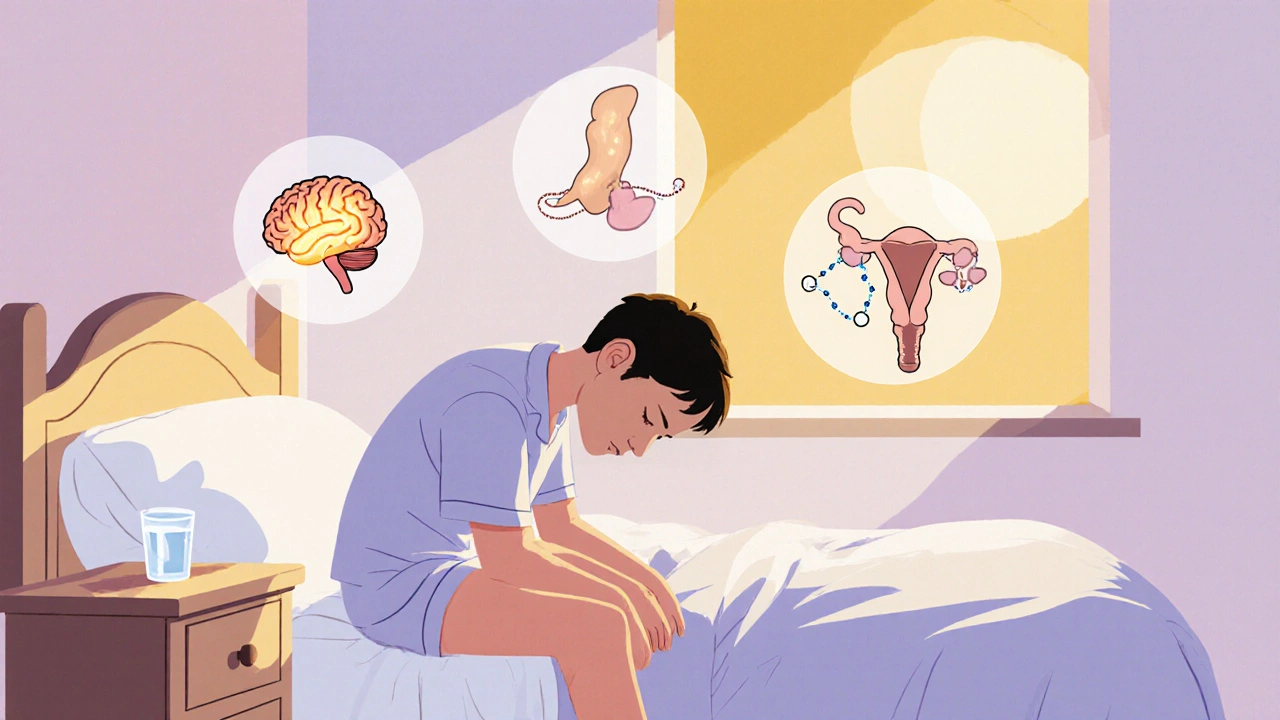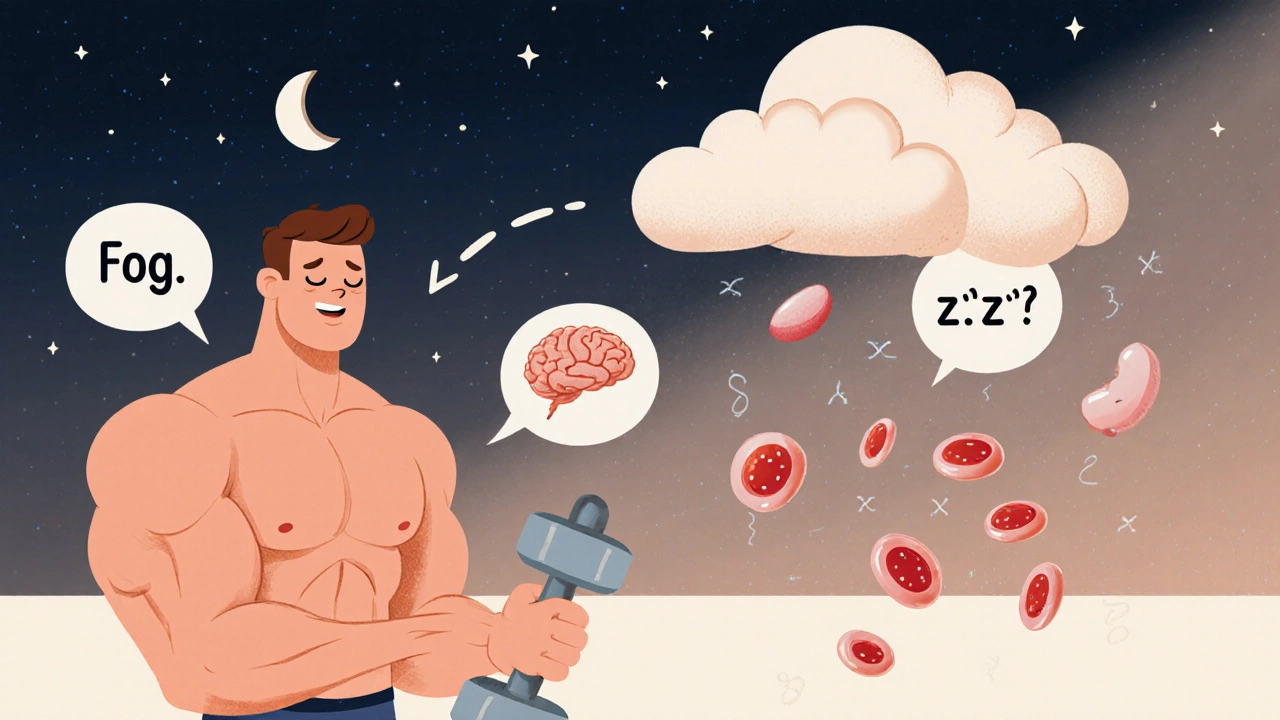Secondary Hypogonadism and Chronic Fatigue: Causes, Symptoms, and Treatment
 Oct, 23 2025
Oct, 23 2025
You might have heard that secondary hypogonadism can make you feel wiped out.
When the body’s hormone system falters, Secondary hypogonadism is a condition where the pituitary gland or hypothalamus fails to stimulate the testes, leading to low testosterone production. The result often overlaps with Chronic fatigue, a persistent sense of exhaustion that doesn’t lift after a good night’s sleep.
Quick Takeaways
- Secondary hypogonadism stems from pituitary or hypothalamic problems, not testicular failure.
- Low testosterone can drive the same energy‑drain you see in chronic fatigue syndrome.
- Key lab clues: low testosterone with low or normal LH/FSH.
- Treatment focuses on fixing the hormonal axis and supporting lifestyle factors.
- Regular screening is vital for anyone with unexplained fatigue and sexual symptoms.
What Is Secondary Hypogonadism?
In simple terms, the hypothalamus releases Gonadotropin‑releasing hormone (GnRH), which tells the pituitary gland to secrete Luteinizing hormone (LH) and Follicle‑stimulating hormone (FSH). These two hormones travel to the testes and tell them to produce Testosterone. If the hypothalamus or pituitary misfires, the whole chain stalls, and testosterone levels drop.
Common culprits include pituitary tumors, head trauma, radiation, certain medications (like opioids), and systemic illnesses that suppress the gland’s function.
How Low Testosterone Fuels Chronic Fatigue
Testosterone isn’t just a sex hormone; it’s a metabolic powerhouse. It influences muscle mass, red‑blood‑cell production, mood, and even sleep quality. When levels fall:
- Muscle fibers become weaker, making everyday tasks feel harder.
- Red‑blood‑cell counts dip, reducing oxygen delivery to tissues.
- Brain chemistry shifts, often leading to low mood or brain‑fog.
- Sleep architecture can deteriorate, especially the deep‑sleep stages that restore energy.
All of these changes mirror the hallmark symptoms of chronic fatigue: persistent tiredness, reduced stamina, and difficulty concentrating.

Key Hormones and Their Roles
Understanding the hormonal players helps demystify why fatigue shows up.
- Testosterone - Drives muscle protein synthesis, erythropoiesis, and libido.
- LH - Directly stimulates testosterone production in Leydig cells.
- FSH - Supports sperm production but also ties into overall gonadal health.
- Cortisol - The stress hormone; chronic elevation can blunt testosterone response and amplify fatigue.
- Thyroid hormones - Often screened alongside testosterone because hypothyroidism also causes low energy.
Overlap With Other Fatigue‑Related Conditions
It’s easy to mistake secondary hypogonadism for other disorders that cause exhaustion. Here’s a quick look at the most common look‑alikes:
| Condition | Primary Hormonal Marker | Typical Lab Pattern | Key Distinguishing Symptom |
|---|---|---|---|
| Secondary hypogonadism | Testosterone | Low T, low/normal LH, low/normal FSH | History of pituitary disease or medication use |
| Primary hypogonadism | Testosterone | Low T, high LH, high FSH | Testicular atrophy, early onset of symptoms |
| Chronic fatigue syndrome (ME/CFS) | None specific | Often normal endocrine labs | Post‑exertional malaise lasting >24 hrs |
| Hypothyroidism | Thyroid hormone (TSH, free T4) | High TSH, low free T4 | Cold intolerance, dry skin |
| Sleep apnea | None specific | Often normal labs; nocturnal desaturation | loud snoring, witnessed apneas |
Diagnosis Checklist
If you suspect a hormonal link, a clinician will typically run the following:
- Serum total and free testosterone (morning sample).
- LH and FSH levels to differentiate primary vs secondary.
- Prolactin - high levels can suppress GnRH.
- Thyroid panel - rules out hypothyroidism.
- Basic metabolic panel - checks for anemia or electrolyte issues.
Imaging (MRI of the pituitary) is ordered only when labs point to a central problem.

Management & Treatment Options
Therapy aims at two fronts: restoring testosterone and addressing the root cause of the hormonal blockade.
- Testosterone Replacement Therapy (TRT) - Gels, patches, injections, or pellets. Ideal for men whose pituitary can’t be fixed.
- Pituitary‑targeted treatment - Dopamine agonists for prolactinomas, surgery or radiotherapy for tumors, or medication adjustment (e.g., tapering opioids).
- Stress reduction - Mind‑body techniques lower cortisol, which in turn can improve testosterone response.
- Exercise - Resistance training boosts natural testosterone production and combats muscle loss.
- Sleep hygiene - Aim for 7‑9 hours, cool environment, and screen‑free bedtime to protect hormonal rhythm.
Monitoring is key. Re‑check testosterone and LH/FSH every 3‑6 months after starting therapy.
Lifestyle Tips to Combat Fatigue While Treatment Takes Effect
- Eat protein‑rich meals (lean meat, beans, dairy) to supply amino acids for hormone synthesis.
- Include healthy fats (avocado, nuts, olive oil) - cholesterol is the building block for testosterone.
- Stay hydrated; dehydration can magnify feelings of tiredness.
- Limit alcohol - it interferes with the hypothalamic‑pituitary axis.
- Schedule short, frequent breaks during the day to avoid over‑exertion.
Frequently Asked Questions
Can secondary hypogonadism cause weight gain?
Yes. Low testosterone reduces muscle mass and slows metabolism, which can lead to an increase in body fat, especially around the abdomen.
Is fatigue the first symptom of secondary hypogonadism?
Fatigue is often one of the earliest complaints, but many men also notice a drop in libido, erectile difficulties, or mood changes before the tiredness becomes obvious.
Do women experience secondary hypogonadism?
Women can have a similar pituitary‑driven decline in estrogen and testosterone, leading to fatigue, low libido, and bone density loss. The diagnostic labs focus on LH, FSH, estradiol, and testosterone.
How long does it take to feel better after starting TRT?
Most patients notice an improvement in energy and mood within 4‑6 weeks, though maximal muscle‑strength gains may take 3‑6 months.
Can lifestyle changes reverse secondary hypogonadism without medication?
If the underlying cause is reversible (e.g., medication‑induced or chronic stress), lifestyle tweaks combined with clinical oversight can restore hormone balance. Persistent structural pituitary problems usually need medical intervention.
Bottom line: secondary hypogonadism is a hidden driver of chronic fatigue for many men and women. By recognizing the hormonal link, getting the right labs, and pursuing targeted treatment, you can reclaim energy and improve overall health.

Nathan S. Han
October 23, 2025 AT 23:03When you dive into the labyrinth of secondary hypogonadism, the first thing that hits you is a profound sense of betrayal by your own body. The pituitary, that tiny master conductor, decides to skip a beat, and the cascade of hormones that should keep you vibrant fizzles out. Suddenly, the muscles that once carried you through the day feel like lead, and even the simplest chores become uphill battles. Your red blood cells, once diligent couriers of oxygen, dwindle, leaving every breath feeling shallow and insufficient. The brain, deprived of its usual hormonal fuel, fogs over, and you find yourself staring at a screen, unable to focus on anything beyond the blinking cursor. Sleep, which should be a sanctuary, turns into a restless theater where deep, restorative stages never make an appearance. All the while, cortisol-your stress hormone-lurks in the background, amplifying the fatigue and sabotaging any attempts at recovery. It’s no wonder that patients report a cascade of symptoms that mirror chronic fatigue syndrome, yet the root cause remains hidden in the endocrine vault. Diagnosis, therefore, becomes a detective story: measuring testosterone, LH, and FSH, and interpreting whether the low testosterone is a primary failure of the testes or a secondary signal from the brain. Imaging studies, such as an MRI of the pituitary, may reveal a tumor or structural abnormality that explains the hormonal blackout. Treatment, however, offers hope: testosterone replacement therapy can refill the hormonal tank, while targeted interventions-like dopamine agonists for prolactinomas-address the upstream blockage. Lifestyle changes, including resistance training, adequate protein intake, and disciplined sleep hygiene, act as adjuncts, amplifying the benefits of medical therapy. Patients often notice an uplift in mood and vigor within weeks, but the true restoration of muscle strength and stamina may take several months. Monitoring labs every few months ensures that the therapy stays on track and avoids excess. In essence, understanding the interplay between the hypothalamus, pituitary, and testes turns a mysterious fatigue into a manageable condition, allowing individuals to reclaim their energy and zest for life.
Ed Mahoney
October 24, 2025 AT 19:37Oh great, another hormone thing that makes you feel like a busted phone battery. Yeah, sure, “just get some TRT” and you’ll be back to crushing deadlifts. Bet the docs love that, easy fix, right? Maybe if you stop binge‑watching Netflix at 2 am you won’t feel so wiped. Just saying.
Brian Klepacki
October 25, 2025 AT 16:10Behold, the grand tapestry of endocrine dysregulation, woven with the finest threads of academic pretension. One must marvel at the exquisite nuance of a pituitary that decides, on a whim, to withhold its blessed gonadotropins. Such a scenario, dear interlocutors, is not merely a medical quandary but a philosophical commentary on the very nature of control. The afflicted soul, ensnared in a labyrinth of fatigue, is forced to confront the stark reality of hormonal insufficiency. One could argue that this is the body’s subliminal protest against modern excesses-a cathartic rebellion, if you will. Yet, let us not descend into melodrama; the evidence is as clear as a well‑crafted meta‑analysis. A judicious regimen of testosterone replacement, coupled with targeted pituitary therapy, shall restore equilibrium. And, of course, we must not neglect the ancillary pillars of nutrition, resistance training, and circadian rhythm optimization. In sum, the path to revitalization is a symphony of interdisciplinary mastery, awaiting only the conductor’s baton.
Selina M
October 26, 2025 AT 11:43hey folks i totally get how exhausting this can be its like your body hit the snooze button forever lol just remember to keep moving even if its tiny steps and eat some good protein it really helps
Nicholai Battistino
October 27, 2025 AT 08:17Focus on steady progress-short walks, balanced meals, regular check‑ups. Consistency beats intensity.
Katherine Collins
October 28, 2025 AT 04:50meh, sounds like another excuse to sell pills 😂
Taylor Nation
October 29, 2025 AT 01:23We should all share what’s worked for us; I found that a mix of light resistance training and a bedtime routine without screens made a huge difference. It’s important we keep each other motivated and not just point out the problem.
Javier Muniz
October 29, 2025 AT 21:57Totally agree with you! I started a simple push‑up routine and turned off my phone an hour before bed-energy levels have gone up noticeably.
Sarah Fleming
October 30, 2025 AT 18:30Wake up, sheeple! They don’t want you to know that the “magic bullet” of testosterone is merely a smokescreen for a deeper conspiracy. The very institutions that profit from chronic fatigue are silently funding research that hides the truth about hormonal manipulation. Every lab result, every clinical guideline, meticulously crafted to keep the masses docile. They whisper about “pituitary tumors” while the real puppet masters tweak your endocrine system from behind the curtain. Open your eyes, question every textbook, and demand full transparency-your energy is being siphoned for their profit.
Joey Yap
October 31, 2025 AT 15:03It’s fascinating how the body’s internal chemistry can mirror our existential state. When hormones fall out of balance, it feels like a misalignment of one’s inner compass. Yet, the humility to accept that we are part of a larger physiological network can be grounding. By attending to both medical treatment and mindful lifestyle, we honor the intricate dance between mind and body.
Kelvin Egbuzie
November 1, 2025 AT 11:37Sure, blame the “big pharma” while sipping your energy drink. 🙄 If only a secret cabal could fix your morning coffee habit.
tatiana anadrade paguay
November 2, 2025 AT 08:10Remember, a supportive community and personalized medical care go hand in hand. If you’re feeling stuck, reach out to a trusted provider and keep sharing your progress with friends-together we can navigate this journey.